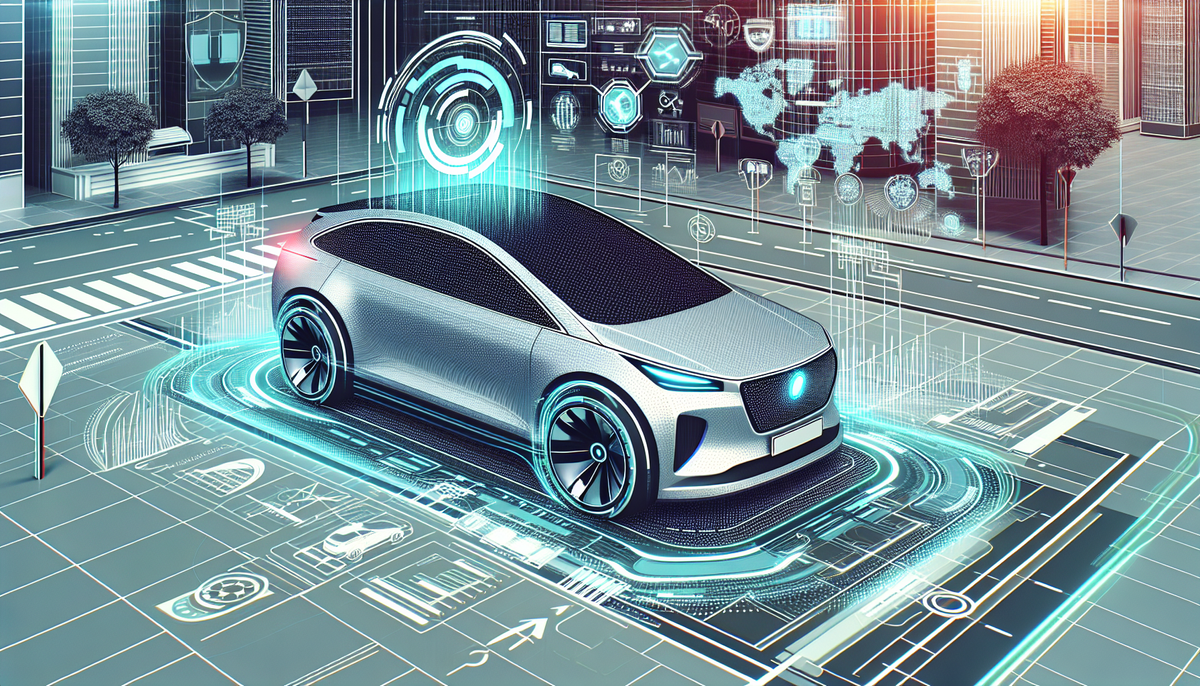AI-Driven Driverless Cars: Outperforming Human Safety?

Introduction: The AI-Driven Transportation Revolution
Autonomous vehicles are at the forefront of a technology revolution. With innovations in AI-driven sensor technology and complex algorithms, companies like Waymo are pushing the boundaries of safety in transportation. In a recent analysis covering over 50 million miles of driverless operations, Waymo has not only set new benchmarks in crash reduction but also sparked a debate on whether driverless cars might soon surpass human safety standards. This article dives deep into Waymo's crash data, comparing it to human-driven vehicles and exploring the technical advances that make these vehicles safer.
Understanding Waymo's Safety Record
Waymo's recent data reveals a compelling safety story. Over 50 million miles of autonomous operation, Waymo vehicles have encountered significantly fewer crashes compared to human-operated cars. While every incident is scrutinized in detail, the key takeaway is that a vast majority of serious accident reports involve human error rather than any flaw in Waymo's technology.
Historically, the analysis of Waymo's crash data shows that:
- Most incidents involved other vehicles failing to obey traffic rules.
- Over 80% of serious crashes were due to actions by human drivers, such as speeding or running red lights.
- Even in scenarios involving multi-vehicle pileups, Waymo vehicles maintained strict adherence to traffic regulations.
These findings highlight not only the potential of AI-driven systems in reducing accidents but also emphasize how traditional human error remains one of the leading causes of road mishaps.
The Science Behind the Safety
At the core of Waymo's success is advanced artificial intelligence integrated with cutting-edge sensor arrays and real-time data processing. The key components include:
- Deep Learning Algorithms: These systems continuously analyze environmental data, ensuring that the vehicle reacts optimally to dynamic road conditions.
- High-Resolution Sensors: Lidar, radar, and high-definition cameras provide a 360-degree view that allows Waymo vehicles to detect obstacles, pedestrians, and other vehicles with precision.
- Predictive Analytics: By forecasting the behavior of nearby vehicles and pedestrians, these systems preemptively adjust driving patterns to avoid potential collisions.
This blend of technology not only contributes to fewer accidents but also positions Waymo at the forefront of the driverless car sector, where efficiency and safety merge seamlessly.
Comparative Analysis: Waymo vs. Human Drivers
One of the most significant metrics in evaluating autonomous vehicle safety is comparing the crash rates per mile between AI-driven vehicles and human drivers. Waymo’s data, when placed alongside human performance, reveals:
- Airbag-Deploying Crashes: In an analysis over 44 million miles in major markets, Waymo reported 13 airbag-triggering events, compared to an estimated 78 by human drivers—a reduction of approximately 83% in such incidents.
- Injury-Causing Crashes: With 36 injury-causing incidents reported for Waymo over the same distance, the reduction compared to human drivers stands at roughly 81%.
- Insurance Claims: Data shows that successful insurance claims related to injuries and property damage are around 90% lower for Waymo vehicles. The significance of these statistics is that not only are the AI-driven vehicles involved in fewer accidents, but the severity and aftermath of these incidents are also minimized.
The Role of Insurance Data and External Validation
To further cement confidence in their technology, Waymo’s crash reports are cross-validated with independent insurance data. Third-party insurance adjusters evaluate the incidents, providing an impartial review of fault in accidents. For instance, while one notable crash involved an out-of-control driver causing a multi-vehicle pileup, an independent analysis pointed out that Waymo’s adherence to traffic laws was a critical factor in preventing more severe outcomes.
This external validation is crucial because it reinforces the notion that an autonomous vehicle's fault rate is significantly lower than that of human drivers. In one study from Swiss Re, commissioned by Waymo, insurance claims against autonomous vehicles were dramatically reduced when compared to estimates based on human driving behavior. Even with pending claims being carefully evaluated, the data suggests that AI-driven vehicles offer a potential pathway to safer roadways in the future.
Challenges and Ongoing Developments
Despite the remarkable stats, the journey towards complete safety in autonomous driving isn’t without its challenges. Some key issues include:
- Circumstantial Crashes: In certain complex traffic scenarios, the data shows collisions that, while minor, require significant improvements in AI decision-making, especially in unpredictable urban environments.
- Mixed Traffic Conditions: Autonomous vehicles must coexist with human-driven cars that can behave erratically. Developing robust systems to handle such unpredictability remains a high priority.
- Regulatory Hurdles: As the industry evolves, regulatory frameworks must adapt to ensure that safety standards keep pace with technological advancements. Coordination between tech companies and government agencies is essential to maintain public trust.
Waymo is actively addressing these challenges by enhancing its Safe Exit protocol and refining its algorithms to better accommodate sudden changes in driving patterns. Continuous testing in diverse environments, ranging from congested urban centers to suburban roads, is key to achieving even higher safety standards.
Expert Opinions and Industry Impact
Industry experts and academic researchers have applauded the progress shown by AI-driven vehicles. Many point out that the reduction in crash rates is a testament to years of rigorous research in AI and machine learning applications in real-world scenarios. Some expert insights include:
- Technology Integration: Researchers from MIT Tech Review and IEEE have consistently highlighted the successful integration of sensor fusion and predictive analytics in autonomous vehicles.
- Public Safety Improvements: Analysts suggest that with further development, driverless cars could significantly reduce road fatalities and injuries. The technology is expected to have a transformative impact on urban planning and public policy.
- Future Developments: As technology evolves, autonomous vehicles may soon incorporate emerging trends such as edge AI processing and blockchain-based IoT security, further enhancing their operational integrity and safety measures.
Implications for the Future of Transportation
The paradigm shift from human-driven to autonomous vehicles is not just a technological upgrade—it is a revolution that could fundamentally alter transportation infrastructure. The implications include:
- Reduced Traffic Fatalities: With crash reductions exceeding 80% in several key categories, a widespread adoption of autonomous vehicles has the potential to save countless lives.
- Increased Efficiency: AI-driven vehicles can optimize routes in real time, reducing congestion and lowering the environmental impact of urban transportation systems.
- Economic Benefits: Fewer accidents translate into lower insurance premiums, reduced healthcare costs, and a more efficient utilization of public resources.
Furthermore, as infrastructure evolves to support autonomous vehicles—such as the development of 5G edge networks that enable faster data transmission—the synergy between emerging technologies will create safer, smarter cities. Policymakers are beginning to emphasize the importance of investing in these technologies to future-proof urban environments, ensuring that safety and efficiency go hand in hand.
Case Studies and Ongoing Research
Several case studies highlight how different regions are benefitting from the integration of driverless technology. For example:
- San Francisco and Phoenix: Detailed studies in these cities have confirmed that traditional human crash rates are significantly higher than those recorded by Waymo's fleet. This provides a data-driven rationale for the broader deployment of autonomous vehicles in similar urban areas.
- Insurance Sector Collaborations: Partnerships between Waymo and global insurers like Swiss Re have led to the development of new safety metrics that accurately reflect real-world performance. These studies are instrumental in setting benchmarks for the entire industry.
Additionally, research from tech journals and whitepapers published by organizations like Arxiv has provided critical insights into the underlying causes of autonomous vehicle crashes. These independent studies reinforce the view that driverless technology, when executed correctly, has the potential to dramatically reduce road accidents.
Conclusion: A Safer Future on the Horizon
The data behind Waymo's extensive 50 million miles of driverless operations presents a compelling narrative of a safer future driven by AI and advanced sensor technologies. With significantly lower crash rates, fewer insurance claims, and robust external validations, the technological advancements powering autonomous vehicles are setting new industry standards. While challenges remain, ongoing research and regulatory adaptations offer a clear pathway toward a transportation landscape where human error is minimized and safety is paramount.
As we transition to this new era of AI-driven driverless cars, the conversation is shifting from skepticism to cautious optimism. The promise of dramatically reduced road accidents is not just an ideal—it is a tangible reality supported by rigorous data and continuous improvements in technology. By leveraging deep learning, high-resolution sensor networks, and predictive analytics, autonomous vehicles are not only reshaping how we travel but also paving the way for smarter, safer cities of the future.
Ultimately, the findings of these studies underscore the importance of embracing technological innovation in transportation. While human drivers have long been the norm, the shift towards AI-driven, driverless cars represents a critical milestone in our quest for safer, more efficient travel. With further enhancements in technology and infrastructure, the potential benefits extend far beyond reduced accidents—they signal a transformative change in how society views mobility and public safety.
As industry leaders continue to innovate and refine the technology behind autonomous vehicles, stakeholders from policymakers to everyday commuters stand to gain from a future where data-driven decisions lead the way. The journey towards completely autonomous, AI-powered transportation is still unfolding, but the evidence is already compelling: driverless cars could very well be the safest way on the road.



Comments ()